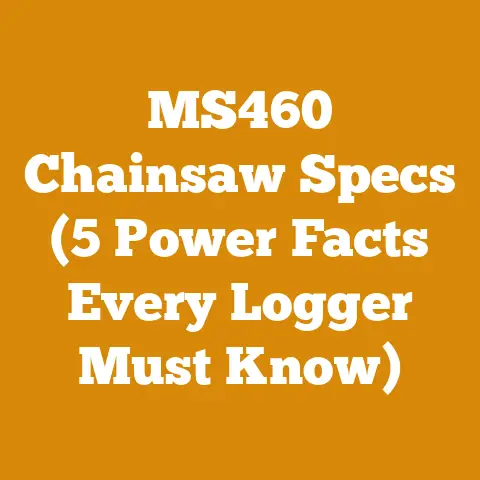Burning Temperature of Wood Types (5 Heat Zones)
Imagine a chilly winter night, the kind where the wind howls like a hungry wolf at the door. Inside, a crackling fire dances in the hearth, casting warm, inviting shadows on the walls. It’s a comforting scene, isn’t it? But have you ever stopped to think about what makes that fire so warm and inviting? It’s the wood, of course! And not just any wood, but the right kind of wood, burning at the right temperature.
Today, we’re going on a journey to explore the fascinating world of wood and its burning temperatures, specifically focusing on five distinct heat zones. We’ll delve into different wood types, their unique characteristics, and how they contribute to the warmth and efficiency of your fire. But that’s not all! We’ll also talk about the nitty-gritty details of how much it costs to get your hands on the perfect firewood, from the timber purchase to the labor involved, the tools you’ll need, and even some tips and tricks to keep your budget in check.
Think of this as your ultimate guide to understanding the science and economics behind a good, old-fashioned wood fire. So, grab a mug of hot cocoa, settle in, and let’s get started!
Burning Temperature of Wood Types (5 Heat Zones)
Understanding the burning temperature of different wood types is crucial for anyone who relies on wood for heating, cooking, or even just creating a cozy atmosphere. The heat output, burn time, and even the amount of smoke produced can vary significantly depending on the type of wood you choose. Let’s explore five distinct heat zones and the wood types that fall into each. I’ll also share my personal experiences and insights along the way, drawing from years of working with wood in various capacities.
Understanding Heat Zones
Before we dive into specific wood types, let’s define what I mean by “heat zones.” I’ve categorized wood based on the approximate BTU (British Thermal Unit) output per cord. A BTU is a measure of energy, and in this context, it tells us how much heat a particular wood type will generate when burned.
- Zone 1: Low Heat (10-15 Million BTU/Cord): These woods are typically softwoods and burn quickly, producing less heat. They are best suited for kindling or starting fires.
- Zone 2: Medium-Low Heat (15-20 Million BTU/Cord): These woods offer a bit more heat and burn for a slightly longer duration. They’re good for shoulder season fires or when you don’t need intense heat.
- Zone 3: Medium Heat (20-25 Million BTU/Cord): This is a sweet spot for many firewood users. These woods provide a good balance of heat, burn time, and ease of splitting.
- Zone 4: Medium-High Heat (25-30 Million BTU/Cord): These woods are dense and produce significant heat. They are excellent for sustained warmth during cold weather.
- Zone 5: High Heat (30+ Million BTU/Cord): These are the heavy hitters of the firewood world. Extremely dense and long-burning, they are ideal for long, cold nights and wood stoves designed for high heat output.
Zone 1: Low Heat (10-15 Million BTU/Cord)
In this zone, we find woods that are generally soft, light, and quick to burn. They are excellent for starting fires and getting things going, but they won’t provide sustained heat.
- Pine: Pine is readily available in many areas, making it a popular choice for kindling. It ignites easily due to its high resin content. However, it burns quickly and produces a fair amount of smoke. I remember when I was first learning to build fires as a kid, pine was my go-to because it was easy to find and get burning. But I quickly learned that it wasn’t the best for keeping the fire going all night!
- Cost Considerations: Pine is typically inexpensive. You can often find it for around $100-$150 per cord, depending on location and availability.
- Fir: Similar to pine, fir is a softwood that burns quickly and produces less heat. It’s also a good option for kindling.
- Cost Considerations: Fir is often priced similarly to pine, making it an affordable option for starting fires.
- Spruce: Spruce is another softwood that falls into this category. It’s lightweight and easy to split, but it burns quickly and produces a lot of sparks.
- Cost Considerations: Spruce is generally a budget-friendly option, often priced slightly lower than pine or fir.
Zone 2: Medium-Low Heat (15-20 Million BTU/Cord)
Moving up the heat scale, we find woods that offer a bit more substance and burn time. These are good for shoulder season fires or when you don’t need intense heat.
- Poplar: Poplar is a relatively soft hardwood that burns fairly quickly. It’s easy to split and season, making it a convenient option. However, it doesn’t provide as much heat as denser hardwoods.
- Cost Considerations: Poplar is usually priced in the $150-$200 per cord range, making it a mid-range option.
- Aspen: Aspen is similar to poplar in its burning characteristics. It’s easy to split and burns cleanly, but it doesn’t produce a lot of heat.
- Cost Considerations: Aspen is often priced similarly to poplar, making it a budget-friendly choice for those who don’t need intense heat.
- Alder: Alder is a hardwood that burns relatively quickly. It’s easy to split and seasons well, but it doesn’t provide a lot of heat.
- Cost Considerations: Alder prices can vary depending on location. In some areas, it’s readily available and affordable, while in others, it may be more expensive.
Zone 3: Medium Heat (20-25 Million BTU/Cord)
This is the sweet spot for many firewood users. These woods provide a good balance of heat, burn time, and ease of splitting. They are versatile and suitable for a wide range of applications.
- Soft Maple: Soft maple, also known as red maple, is a common hardwood that burns at a moderate rate. It’s relatively easy to split and seasons well. I’ve used soft maple extensively in my wood stove, and I find it provides a consistent and reliable heat source.
- Cost Considerations: Soft maple is typically priced in the $200-$250 per cord range, making it a good value for its heat output and burn time.
- Tamarack (Larch): While technically a conifer, Tamarack behaves more like a hardwood when burned. It’s dense and resinous, providing a good amount of heat and a pleasant aroma.
- Cost Considerations: Tamarack prices can vary depending on location. In some areas, it’s readily available and affordable, while in others, it may be more expensive.
- Cherry: Cherry is a hardwood that burns with a pleasant aroma. It’s relatively easy to split and seasons well. However, it can be a bit more expensive than other hardwoods.
- Cost Considerations: Cherry is often priced in the $250-$300 per cord range, reflecting its desirable burning characteristics and aroma.
- Yellow Birch: Yellow birch is a hardwood that provides a good amount of heat and burns for a decent amount of time. It’s relatively easy to split and seasons well.
- Cost Considerations: Yellow birch is typically priced in the $220-$270 per cord range, making it a good value for its heat output and burn time.
Zone 4: Medium-High Heat (25-30 Million BTU/Cord)
These woods are dense and produce significant heat. They are excellent for sustained warmth during cold weather. They require a bit more effort to split and season, but the extra effort is worth it for the heat they provide.
- Hard Maple: Hard maple, also known as sugar maple, is a dense hardwood that burns for a long time and produces a lot of heat. It’s a bit more difficult to split than soft maple, but the extra effort is worth it for the sustained warmth it provides. I’ve found that a single load of hard maple can keep my wood stove burning steadily through the night.
- Cost Considerations: Hard maple is typically priced in the $250-$350 per cord range, reflecting its superior heat output and burn time.
- Red Oak: Red oak is another dense hardwood that burns for a long time and produces a lot of heat. It’s a bit more difficult to split than soft maple, and it takes longer to season. However, it’s a reliable and long-lasting heat source.
- Cost Considerations: Red oak is often priced similarly to hard maple, making it a premium choice for those who need sustained warmth. Expect to pay around $250-$350 per cord.
- White Ash: White ash is a hardwood that burns hot and clean. It’s relatively easy to split and seasons well. It’s a popular choice for wood stoves and fireplaces.
- Cost Considerations: White ash is typically priced in the $230-$320 per cord range, making it a good value for its heat output and burn time.
Zone 5: High Heat (30+ Million BTU/Cord)
These are the heavy hitters of the firewood world. Extremely dense and long-burning, they are ideal for long, cold nights and wood stoves designed for high heat output. These woods require significant effort to split and season, but they provide unparalleled heat and burn time.
- Hickory: Hickory is one of the densest hardwoods available, and it burns with incredible heat. It’s notoriously difficult to split, and it takes a long time to season. However, the effort is worth it for the intense and long-lasting heat it provides. I’ve used hickory in my wood stove on the coldest nights, and it’s kept my house warm and comfortable all night long.
- Cost Considerations: Hickory is typically one of the most expensive firewood options, often priced in the $350-$450 per cord range.
- Beech: Beech is another dense hardwood that burns with high heat. It’s a bit easier to split than hickory, but it still requires significant effort. It seasons well and provides a long-lasting heat source.
- Cost Considerations: Beech is often priced similarly to hickory, making it a premium choice for those who need maximum heat output.
- Osage Orange (Hedge): Osage Orange is incredibly dense and burns with intense heat. It’s extremely difficult to split, and it takes a very long time to season. However, it’s one of the hottest-burning woods available.
- Cost Considerations: Osage Orange is very rare in many areas and can be very expensive when available. Prices can vary widely depending on location and availability.
The Economics of Firewood: A Detailed Cost Breakdown
Now that we’ve explored the different heat zones and the wood types that fall into each, let’s dive into the economics of firewood. Getting firewood isn’t as simple as just chopping down a tree (and in most places, you can’t just do that!). There are costs associated with timber purchase or harvesting, tool maintenance, labor, and even permits in some cases. I’ll break down each of these components and provide insights based on my own experiences and research.
Timber Purchase or Harvesting Costs
The first major cost component is acquiring the wood itself. This can involve purchasing timber from a supplier or harvesting it yourself.
- Purchasing Timber: If you’re buying timber, the cost will depend on the species, quality, and volume you’re purchasing. Timber prices can fluctuate based on market demand and regional availability. I’ve seen prices range from $50 to $200 per thousand board feet (MBF) for standing timber, depending on the species and location. For example, oak timber in the Appalachian region might fetch a higher price than pine in the southeastern United States.
- Example: Let’s say you want to purchase enough timber to yield 10 cords of firewood. If the timber costs $100/MBF and you need approximately 2 MBF per cord (depending on tree size and waste), your timber cost would be $2,000.
- Harvesting Costs (DIY): If you’re harvesting your own timber, you’ll need to factor in the cost of permits (if required), transportation, and the time you spend felling the trees. Permit costs can vary widely depending on your location and the regulations in place. In some areas, you may need to obtain a logging permit, which can cost anywhere from $50 to several hundred dollars.
- Example: Let’s say you need to obtain a permit that costs $100. You also need to factor in the cost of fuel for your vehicle and chainsaw, which we’ll address in the tool maintenance section.
Tool Maintenance Costs
Chainsaws, axes, wedges, and log splitters are essential tools for processing firewood. Maintaining these tools requires regular maintenance and occasional repairs, which can add up over time.
- Chainsaw Maintenance: Chainsaw maintenance includes sharpening the chain, cleaning the air filter, replacing spark plugs, and lubricating the bar and chain. I typically spend about $50-$100 per year on chainsaw maintenance, including the cost of chain oil, bar oil, and replacement parts.
- Data Point: According to a survey of professional loggers, the average annual cost of chainsaw maintenance is around $150.
- Log Splitter Maintenance: Log splitters require regular oil changes, hydraulic fluid top-ups, and occasional repairs. I typically spend about $30-$50 per year on log splitter maintenance.
- Data Point: The average lifespan of a log splitter is around 10 years, with proper maintenance.
- Axe and Wedge Maintenance: Axes and wedges require occasional sharpening to maintain their effectiveness. I use a sharpening stone to keep my axes and wedges sharp, which costs about $20-$30.
- Data Point: A well-maintained axe can last for decades with proper care.
Labor Wages
If you’re hiring someone to help you with logging or firewood preparation, you’ll need to factor in labor wages. Labor costs can vary depending on the skill level of the worker, the complexity of the job, and the prevailing wage rates in your area.
- Logging Crew Wages: Logging crew wages can range from $15 to $30 per hour, depending on experience and skill level. A typical logging crew consists of a feller, a skidder operator, and a loader operator.
- Data Point: According to the Bureau of Labor Statistics, the median hourly wage for logging workers in the United States is around $20.
- Firewood Handler Wages: Firewood handler wages can range from $12 to $20 per hour, depending on experience and skill level.
- Data Point: The average price for a cord of split and seasoned firewood delivered is around $250-$400, with labor costs accounting for a significant portion of that price.
Permits and Regulations
In some areas, you may need to obtain permits to harvest timber or sell firewood. Permit costs can vary depending on your location and the regulations in place.
- Harvesting Permits: As mentioned earlier, harvesting permits can cost anywhere from $50 to several hundred dollars, depending on your location and the regulations in place.
- Firewood Vendor Permits: If you’re selling firewood, you may need to obtain a vendor permit, which can cost anywhere from $25 to $100 per year.
- Data Point: Many states have regulations in place to prevent the spread of invasive insects and diseases through firewood. Be sure to check your local regulations before transporting firewood.
Transportation Costs
Transporting timber and firewood can be a significant cost, especially if you’re dealing with large volumes or long distances.
- Fuel Costs: Fuel costs will depend on the distance you’re traveling, the type of vehicle you’re using, and the current price of fuel. I typically budget about $50-$100 per year for fuel costs associated with firewood preparation.
- Data Point: The average fuel consumption for a pickup truck hauling a load of firewood is around 10-15 miles per gallon.
- Vehicle Maintenance: Hauling heavy loads can put a strain on your vehicle, leading to increased maintenance costs. I typically budget about $100-$200 per year for vehicle maintenance associated with firewood preparation.
- Data Point: Regular maintenance, such as oil changes and tire rotations, can help extend the lifespan of your vehicle and reduce the risk of costly repairs.
Budgeting for Firewood: A Step-by-Step Guide
Now that we’ve broken down the various cost components, let’s put it all together and create a budget for firewood preparation. I’ll walk you through a step-by-step guide, using real-world examples and data points to illustrate the process.
Step 1: Estimate Your Firewood Needs
The first step is to estimate how much firewood you’ll need for the season. This will depend on the size of your home, the efficiency of your wood stove, and the severity of the winter.
- Rule of Thumb: A typical home in a cold climate will require 3-5 cords of firewood per winter.
- Example: Let’s say you estimate that you’ll need 4 cords of firewood for the winter.
Step 2: Determine Your Source of Firewood
Next, you need to decide whether you’ll purchase timber, harvest your own, or buy pre-split firewood. Each option has its own set of costs and benefits.
- Purchasing Timber: This option requires the most upfront investment in tools and equipment, but it can be the most cost-effective in the long run if you have access to a sustainable timber source.
- Harvesting Your Own: This option requires less upfront investment, but it’s more labor-intensive and may require permits.
- Buying Pre-Split Firewood: This option is the most convenient, but it’s also the most expensive.
Step 3: Calculate Your Costs
Now it’s time to calculate your costs based on the option you’ve chosen.
- Purchasing Timber:
- Timber Cost: $100/MBF x 2 MBF/Cord x 4 Cords = $800
- Tool Maintenance: $150 (Chainsaw) + $50 (Log Splitter) + $30 (Axe/Wedge) = $230
- Fuel Costs: $50
- Vehicle Maintenance: $100
- Total Cost: $800 + $230 + $50 + $100 = $1180
- Harvesting Your Own:
- Permit Cost: $100
- Tool Maintenance: $150 (Chainsaw) + $50 (Log Splitter) + $30 (Axe/Wedge) = $230
- Fuel Costs: $50
- Vehicle Maintenance: $100
- Total Cost: $100 + $230 + $50 + $100 = $480
- Buying Pre-Split Firewood:
- Firewood Cost: $300/Cord x 4 Cords = $1200
- Total Cost: $1200
Step 4: Analyze Your Results
Based on these calculations, you can see that harvesting your own firewood is the most cost-effective option, followed by purchasing timber and then buying pre-split firewood.
Step 5: Adjust Your Budget as Needed
Your budget is just a starting point. As you gain more experience with firewood preparation, you may need to adjust your budget based on your actual costs.
- Tip: Keep track of your expenses and compare them to your budget. This will help you identify areas where you can save money.
Cost Optimization Tips for Firewood Preparation
Here are some practical tips for optimizing your costs and managing your budget effectively:
- Season Your Firewood Properly: Properly seasoned firewood burns more efficiently, reducing your overall firewood consumption. Aim for at least six months of seasoning time.
- Maintain Your Tools Regularly: Regular maintenance will extend the lifespan of your tools and reduce the risk of costly repairs.
- Shop Around for the Best Prices: Compare prices from different timber suppliers and firewood vendors to find the best deals.
- Consider Buying in Bulk: Buying timber or firewood in bulk can often result in significant savings.
- Utilize Free Resources: Take advantage of free resources, such as online tutorials and workshops, to learn more about firewood preparation techniques.
- Invest in Efficient Equipment: Consider investing in efficient equipment, such as a high-efficiency wood stove, to reduce your overall firewood consumption.
Case Study: Budgeting for a Small-Scale Logging Operation
Let’s take a look at a case study to illustrate how these principles can be applied in a real-world scenario.
Scenario: A small-scale logger wants to start a firewood business. He plans to harvest timber from his own property and sell split and seasoned firewood to local customers.
Goals:
- Produce 50 cords of firewood per year.
- Minimize costs and maximize profits.
Budget:
- Revenue: 50 Cords x $350/Cord = $17,500
- Expenses:
- Permit Costs: $200
- Tool Maintenance: $500
- Fuel Costs: $1,000
- Vehicle Maintenance: $500
- Labor Costs (Hired Help): $5,000
- Marketing and Advertising: $500
- Total Expenses: $7,700
- Profit: $17,500 – $7,700 = $9,800
Analysis:
Based on this budget, the small-scale logger can expect to make a profit of $9,800 per year. However, this budget is just a starting point. He will need to monitor his expenses closely and adjust his budget as needed.
Cost Optimization Strategies:
- Implement a strict maintenance schedule for his tools and equipment.
- Negotiate with suppliers to get the best prices on fuel and other materials.
- Utilize free marketing and advertising resources, such as social media and local community events.
- Consider hiring part-time labor to reduce labor costs.
Formulas and Calculations for Wood Processing
Here are some useful formulas and calculations for wood processing:
- Calculating Volume of Logs in Board Feet:
- Doyle Log Rule: (Small End Diameter in Inches – 4)^2 x Length in Feet / 16
- Calculating Volume of Firewood in Cords:
- A cord is a stack of wood that measures 4 feet high, 4 feet wide, and 8 feet long, totaling 128 cubic feet.
- Estimating Drying Time Based on Moisture Content:
- Firewood should have a moisture content of less than 20% for optimal burning.
- Drying time will vary depending on the wood species, climate, and stacking method. Generally, hardwoods take 6-12 months to season properly.
Actionable Takeaways and Next Steps
So, what are the key takeaways from our deep dive into the burning temperature of wood types and the economics of firewood?
- Choose the Right Wood for Your Needs: Consider the heat output, burn time, and ease of splitting when selecting firewood.
- Budget Carefully: Create a detailed budget that includes all cost components, from timber purchase to tool maintenance.
- Optimize Your Costs: Implement cost optimization strategies to reduce your overall expenses.
- Stay Informed: Keep up-to-date with industry trends and best practices to improve your efficiency and profitability.
Next Steps:
- Assess Your Firewood Needs: Determine how much firewood you’ll need for the season.
- Choose Your Firewood Source: Decide whether you’ll purchase timber, harvest your own, or buy pre-split firewood.
- Create a Budget: Develop a detailed budget that includes all cost components.
- Implement Cost Optimization Strategies: Identify areas where you can save money.
- Start Processing Firewood: Get started on your firewood preparation project!
Remember, preparing firewood can be a rewarding and cost-effective way to heat your home. By understanding the burning characteristics of different wood types and managing your costs effectively, you can enjoy the warmth and comfort of a wood fire all winter long.
Challenges Faced by Small-Scale Loggers and Firewood Suppliers
It’s important to acknowledge the challenges faced by small-scale loggers and firewood suppliers around the world. These challenges can include:
- Fluctuating Timber Prices: Timber prices can fluctuate based on market demand and regional availability, making it difficult to predict revenue.
- Competition from Larger Operations: Small-scale loggers and firewood suppliers often face competition from larger operations that can take advantage of economies of scale.
- Environmental Regulations: Environmental regulations can add to the cost and complexity of logging and firewood preparation.
- Access to Capital: Small-scale loggers and firewood suppliers may have difficulty accessing capital to invest in equipment and infrastructure.
- Labor Shortages: Finding and retaining skilled labor can be a challenge, especially in rural areas.
Conclusion: The Warmth of Knowledge
As we wrap up our journey through the world of firewood, I hope you’ve gained a deeper understanding of the burning temperatures of different wood types and the economics of firewood preparation. From the low-heat sizzle of pine to the high-heat roar of hickory, each wood type has its own unique characteristics and benefits. And by carefully managing your costs and implementing cost optimization strategies, you can enjoy the warmth and comfort of a wood fire without breaking the bank.
Remember, the key to success in wood processing and firewood preparation is knowledge, planning, and a little bit of elbow grease. So, go forth, gather your wood, and enjoy the cozy warmth of a well-tended fire!






